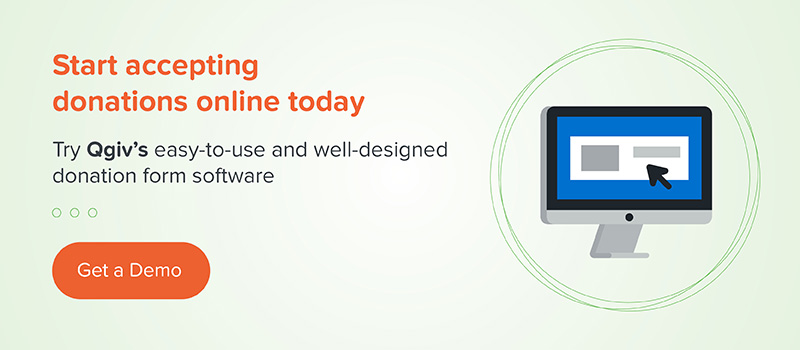Qgiv offers free donation templates to fundraisers looking to better their nonprofit. Use them for corporate donation requests, individual donation requests, and more!
Here at Qgiv, we understand that asking for donations from individuals can be tricky. There are so many questions to be answered before you can even start!
How should we ask for donations?
Who should we ask?
What’s the right way to thank donors?
These and other questions likely go through your head as you’re preparing for an in-person meeting, drafting an email, or writing a letter.
Luckily, we have answers to your questions!
We’ve already written comprehensive articles about the following topics:
- How to Ask for Donations
- Asking for Donations in Person
- Asking for Donations with Letters
- Asking for Donations over the Phone
- Asking for Donations through Facebook
- Asking for Donations with Emails
But we think that an extra lesson in asking for donations from individuals is in order!
Let’s talk about asking for donations from individuals.
While our other articles discuss the different ways you can ask for donations from individuals, this article will cover the steps you need to take to make a successful donation appeal.
Let’s get started.
1. Identify who you’re going to ask.
You have to begin somewhere!
Before you ask for donations, you have to determine who you’re going to solicit for those contributions.
As a general rule, you should start with those closest to your organization including:
- Board members;
- Founders;
- Staff members; or
- Committed volunteers.
These are the easiest people to ask for donations. They are dedicated to your cause and care about helping you see your mission fulfilled.
Once you’ve determined your metaphorical inner circle, it’s time to move outward to:
- Spouses and family members of your inner circle.
- Friends of your inner circle.
- Business colleagues or peers of your inner circle.
Think of fundraising as rings on a tree. You have to start with a small, core group of supporters and eventually work your way out to the edge.
After establishing a solid network of people who are either committed to your cause or have connections to your inner circle, it’s time to broaden your scope.
One of the easiest ways to do this is to perform a prospect screening.
Prospect research essentially looks through your donor database and prospect pool to help you predict giving levels and patterns.
By performing a prospect screening, you can more effectively scope out the lay of the land, so to speak.
Prospect research tells you about a potential donor’s:
- Past giving to your organization;
- Previous donations to other nonprofits;
- Political giving;
- Stock ownership;
- Real estate ownership;
- Basic data like address, names, birthdays, etc.
Prospect research can be a huge help when you’re trying to determine who your fundraisers should focus on when asking for donations.
Takeaway: Start with those closest to your organization and move outward. Then, conduct a prospect screening to narrow down your search.
2. Prepare for the appeal.
Because you can ask for donations from individuals in a multitude of ways, this section will be a bit broad.
Essentially, preparing for an appeal requires studying your donors to determine the best way to ask them for donations.
Does Debbie Donor always mail in her donations?
Ask her for donations with letters or other direct mail.
Does Sean Supporter always give online?
Send him an email to encourage him to visit your donation page.
Look back in your donor database to plot out the best way to reach out to donors.
You’ll also want to take a look at your donor relationships and segment your communications accordingly.
For instance, you wouldn’t want to send a monthly donor the same appeal that you’d send someone who just started volunteering with your organization.
All of your supporters are different and have various relationships with your organization. Don’t alienate them by sending appeals that aren’t tailored to them!
Takeaway: Prepare for asking for donations by researching your donors’ preferences. Then, segment your communications accordingly.
3. Make the ask!
After you’ve researched and prepared, it’s time to make your donation appeal!
Some key tips to remember when asking for donations with any method:
- Be genuine. Donors won’t respond well to insincerity. Be authentic when asking for donations to increase the chances of a positive response.
- Be donor-centric. Remind supporters of what they can get out of donating. Let them know why they matter
- Explain your mission. People don’t give to organizations; they give to people and causes. Make sure your donors know what their money is going toward.
- Make it personal. If you send a letter, sign it. If you send an email, include pictures of projects. If you call donors, tell them a success story.
- Understand that not everyone will donate. Be prepared to be turned down. Know when to offer other giving opportunities and when to walk away.
Making the official donation ask can be the most nerve-wracking part of the fundraising experience. But if you’ve done your research and prepared your fundraising team, you’ll be more than ready to ask for those contributions!
Explore our top fundraising letter templates for examples of language that works well for individual donation solicitations.
Takeaway: Make your donation appeals personal and donor-centric for the best results.
4. Say thank you.
Your organization must thank donors immediately after you receive a donation.
Gratitude is one of the most important components of donor stewardship. The sooner you thank donors, the better.
As a general rule, you should thank donors in the way that you regularly communicate with them.
Remember Debbie Donor who mails in her checks?
Send her a letter saying thank you.
What about Sean Supporter who regularly uses your online donation form?
Send him an email thanking him for his contribution.
Additionally, your acknowledgements can serve as donation receipts for donors’ tax deductions.
Don’t think that your organization is off the hook just because you sent an acknowledgement, though!
You should reference past giving in future communications:
- When you give donors updates about projects, tell them you appreciate their previous contributions.
- Before making a donation appeal a few months or a year later, say thank you for the last one.
- When extending an invitation to an event or fundraiser, express your gratitude.
Gertrude Stein once said that, “Silent gratitude isn’t very much use to anyone.”
Takeaway: Make sure your donors hear your appreciation loud and clear.
5. Provide updates.
Admittedly, this part of the process isn’t directly related to asking for donations, but it can improve your chances of donors offering additional support in the future. Donors want to know what their donations went toward, and your organization has an obligation to give them updates!
You can let your donors know what’s going on by:
- Emailing them a newsletter;
- Providing social media updates with images;
- Sending direct mail newsletters;
- Hosting an event to celebrate the completion of a project;
- And more!
Giving your donors updates on the projects that their donations helped fund will not only show them that you’re a good steward of their funds, but it will also encourage them to give again in the future.
Takeaway: Show donors what their donations are going toward to develop a stronger connection with your supporters.
Asking individuals for donations can be simple if you follow a process. Depending on how you’re communicating with donors, the steps in this list may change slightly, but we offer them as general guidelines for nonprofits trying to raise more money.
Check out the most frequently asked fundraising questions!
What about your organization? What’s your go-to strategy for asking for donations from individuals? What’s the best tip you would give a fundraiser?








